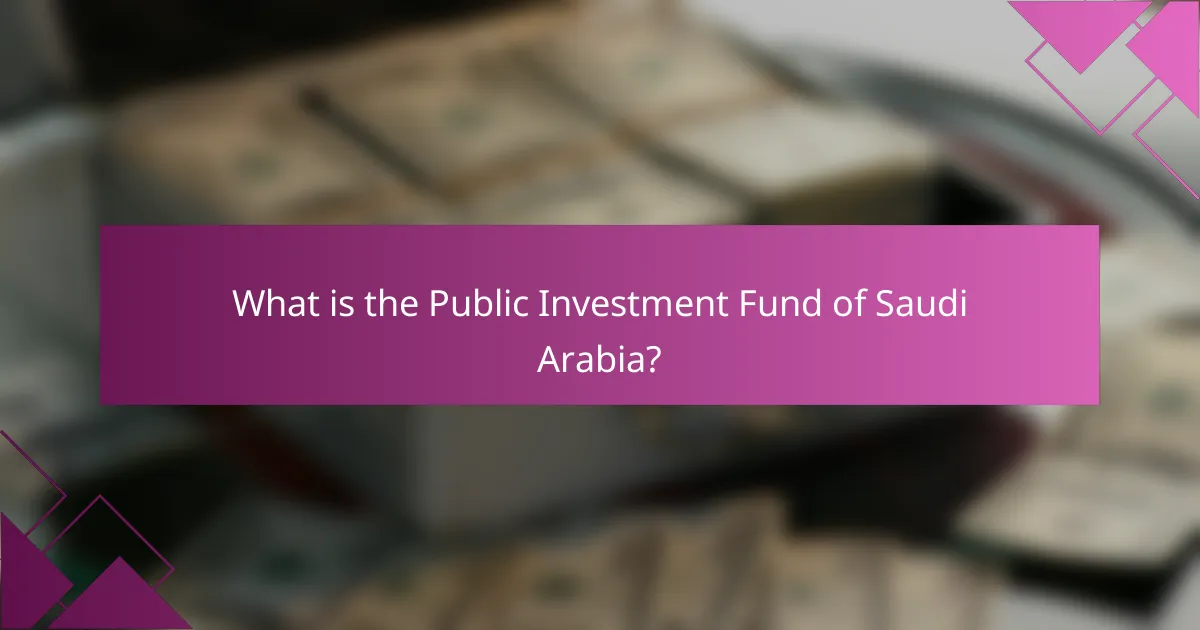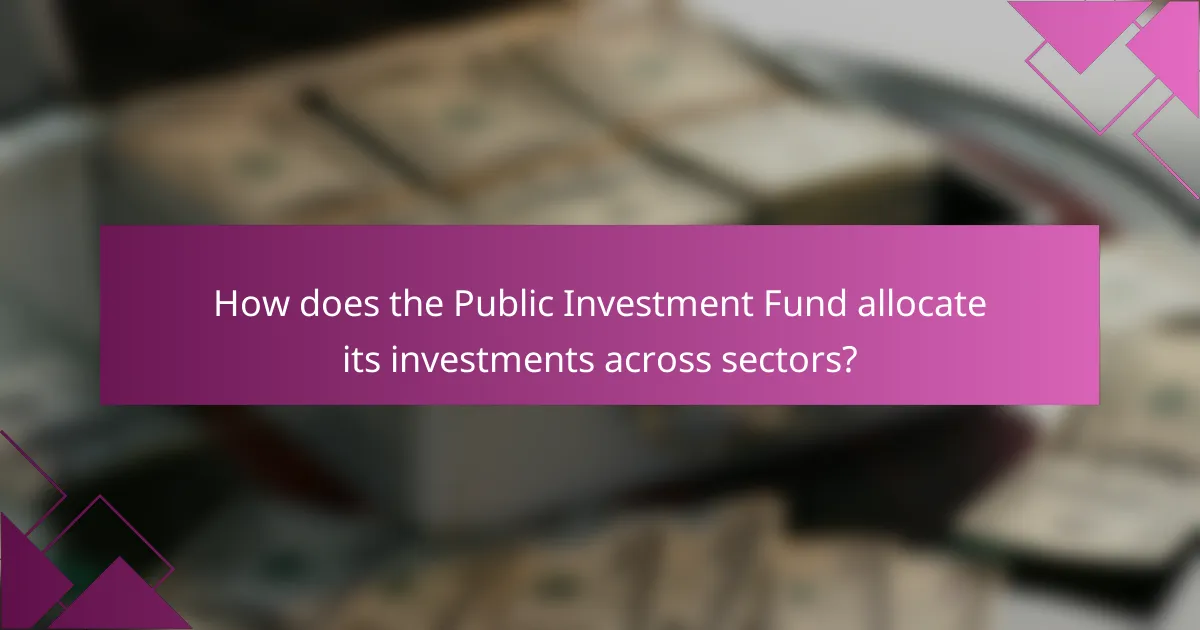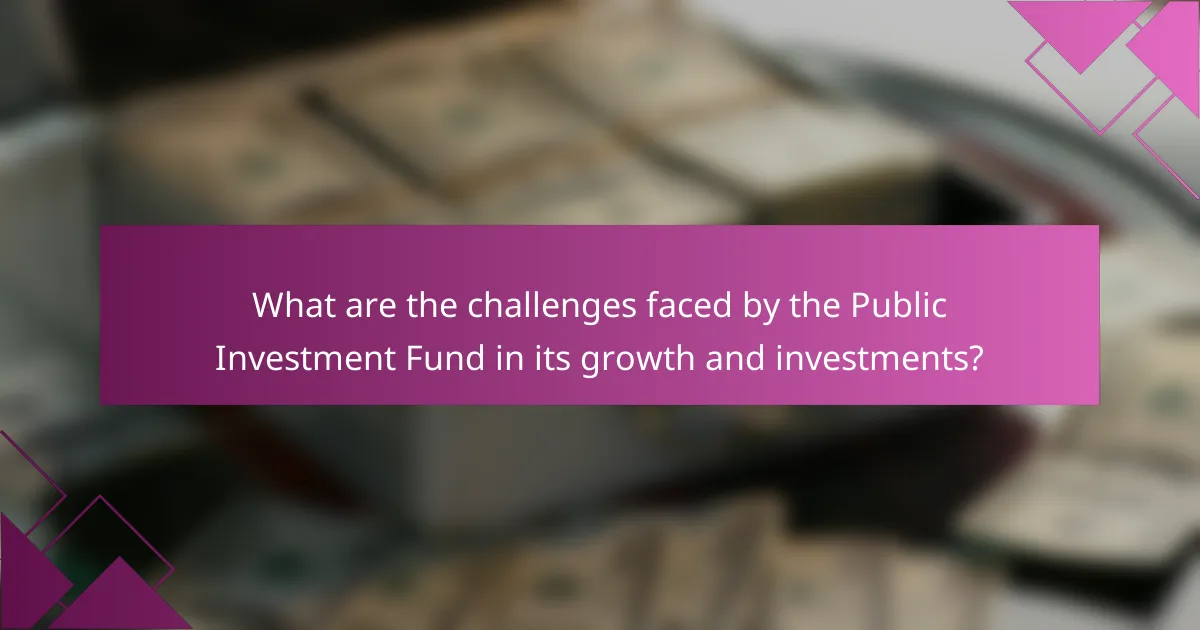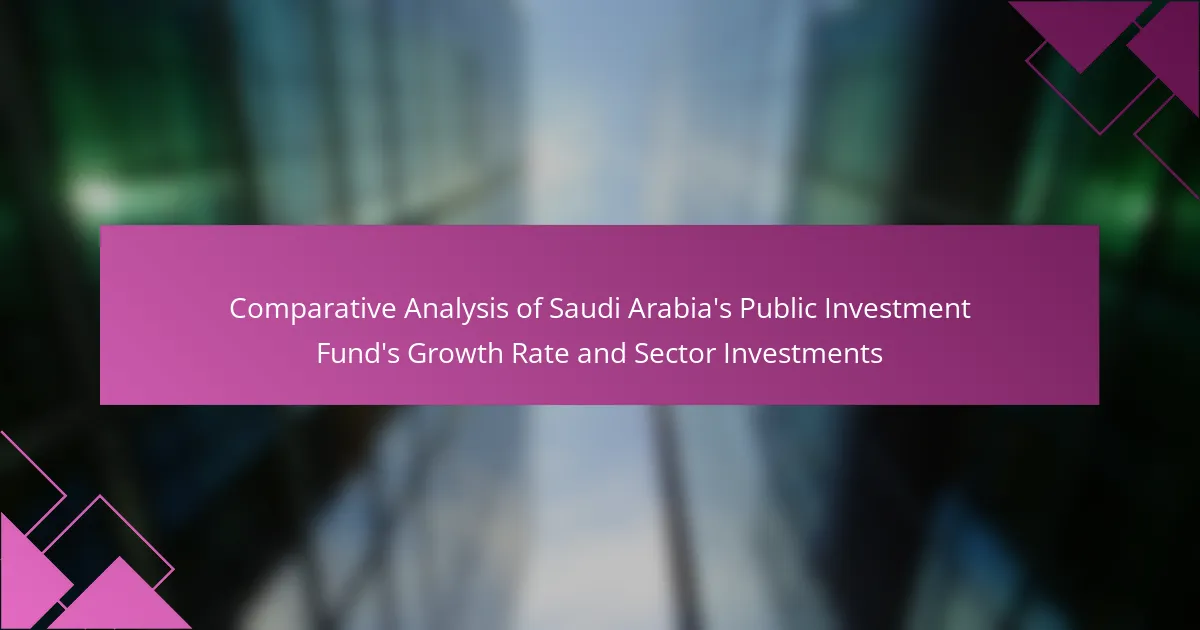
What is the Public Investment Fund of Saudi Arabia?
The Public Investment Fund of Saudi Arabia is the sovereign wealth fund of the Kingdom of Saudi Arabia. It was established in 1971 to invest funds on behalf of the government. The fund aims to diversify the economy away from oil dependency. It invests in various sectors including technology, real estate, and entertainment. As of 2023, the fund’s assets are estimated to exceed $600 billion. The fund plays a crucial role in Vision 2030, Saudi Arabia’s strategic framework for economic reform. It seeks to enhance the country’s global investment footprint. The Public Investment Fund is known for its significant investments in companies like Uber and Lucid Motors.
How was the Public Investment Fund established?
The Public Investment Fund (PIF) of Saudi Arabia was established in 1971. It was created to support the country’s economic development and diversification efforts. Initially, the PIF focused on investing in domestic projects. Over the years, its mandate expanded to include international investments. The fund aims to generate returns that contribute to the national economy. In 2016, a significant restructuring occurred to enhance its role in Vision 2030. This vision aims to reduce the kingdom’s dependence on oil. The PIF has since become a key player in global investments, focusing on various sectors.
What are the primary objectives of the Public Investment Fund?
The primary objectives of the Public Investment Fund (PIF) include diversifying Saudi Arabia’s economy, maximizing returns on investments, and supporting the country’s Vision 2030 goals. The PIF aims to reduce reliance on oil revenues by investing in various sectors. It focuses on both domestic and international investments to enhance economic growth. The fund seeks to create job opportunities and foster innovation within the kingdom. Additionally, it aims to attract foreign investments to Saudi Arabia. The PIF also supports strategic projects that align with national priorities. Its investments are designed to generate sustainable economic benefits for the country.
What role does the Public Investment Fund play in Saudi Arabia’s economy?
The Public Investment Fund (PIF) plays a critical role in Saudi Arabia’s economy by diversifying its revenue sources. PIF aims to reduce the kingdom’s dependence on oil revenues. It invests in various sectors, including technology, entertainment, and renewable energy. The fund manages assets worth over $600 billion as of 2023. PIF’s investments support the Vision 2030 initiative, which seeks to transform the Saudi economy. The fund enhances foreign investment by partnering with global firms. Additionally, it fosters local economic development through job creation. PIF’s strategic investments are designed to yield sustainable economic growth for Saudi Arabia.
What is the significance of the growth rate of the Public Investment Fund?
The growth rate of the Public Investment Fund (PIF) is significant as it reflects the fund’s ability to increase its assets and influence. A higher growth rate indicates effective investment strategies and successful asset management. This growth supports Saudi Arabia’s Vision 2030 objectives by diversifying the economy away from oil dependency. The PIF’s growth also enhances its capacity to invest in key sectors domestically and internationally. For instance, the fund aims to reach assets of $1 trillion by 2030. This target is indicative of the PIF’s strategic importance in fostering economic stability and attracting foreign investment.
How is the growth rate of the Public Investment Fund measured?
The growth rate of the Public Investment Fund (PIF) is measured by analyzing its asset value over time. This is typically done through year-on-year comparisons of total assets under management. Financial metrics such as return on investment (ROI) are also used to assess growth. Additionally, the fund’s performance is evaluated against benchmark indices. These benchmarks provide context for understanding growth relative to market conditions. Tracking investment returns and capital inflows contributes to a comprehensive growth analysis. Reports from financial institutions and the fund’s annual reviews offer concrete data supporting these measurements.
What factors influence the growth rate of the Public Investment Fund?
The growth rate of the Public Investment Fund (PIF) is influenced by several key factors. These factors include government policies, investment strategies, and global economic conditions. Government policies provide the regulatory framework that can either facilitate or hinder growth. Investment strategies, such as diversification and sector focus, directly impact the fund’s performance. Global economic conditions, including market trends and economic stability, also play a significant role. For instance, the PIF’s aggressive investments in technology and renewable energy sectors reflect its strategy to adapt to changing market demands. Additionally, the fund’s growth is supported by Saudi Arabia’s Vision 2030 initiative, which aims to diversify the economy. This initiative encourages investments in various sectors, enhancing the fund’s potential for growth.

How does the Public Investment Fund allocate its investments across sectors?
The Public Investment Fund allocates its investments across various sectors to diversify its portfolio. It primarily focuses on sectors such as technology, healthcare, energy, and entertainment. The fund aims to enhance the Saudi economy by investing in both domestic and international markets. In 2021, approximately 45% of its investments were in technology and innovation sectors. The fund also emphasizes sustainable investments, aligning with Saudi Vision 2030 goals. This strategic allocation supports economic diversification and job creation within the Kingdom. The Public Investment Fund’s approach is designed to maximize returns while mitigating risks across different industries.
What sectors receive the most investment from the Public Investment Fund?
The sectors that receive the most investment from the Public Investment Fund (PIF) include technology, entertainment, and renewable energy. The PIF has significantly invested in global technology firms, aiming to diversify the Saudi economy. In entertainment, the PIF focuses on developing local attractions and events to boost tourism. Renewable energy investments are part of Saudi Arabia’s Vision 2030 initiative to reduce dependence on oil. In 2021, the PIF allocated billions to various projects in these sectors, reinforcing its commitment to economic diversification.
How does the Public Investment Fund prioritize its sector investments?
The Public Investment Fund prioritizes its sector investments based on strategic alignment with national economic goals. It focuses on sectors that drive diversification and sustainability. Key areas include technology, renewable energy, and healthcare. The Fund evaluates potential returns and socio-economic impact. Investments are also guided by global market trends and opportunities. This approach supports Saudi Arabia’s Vision 2030 objectives. The Fund aims to enhance competitiveness and innovation within the economy.
What are the emerging sectors for investment by the Public Investment Fund?
The emerging sectors for investment by the Public Investment Fund include technology, renewable energy, healthcare, and entertainment. The Public Investment Fund aims to diversify Saudi Arabia’s economy. Investments in technology focus on artificial intelligence and digital transformation. Renewable energy investments target solar and wind projects. The healthcare sector is prioritized for advancements in biotechnology and pharmaceuticals. Entertainment investments include tourism and cultural initiatives. These sectors align with Saudi Vision 2030 goals for economic diversification and sustainability.
How does the investment strategy of the Public Investment Fund impact the economy?
The investment strategy of the Public Investment Fund (PIF) significantly impacts the economy by driving economic diversification. The PIF focuses on investing in various sectors such as technology, entertainment, and renewable energy. This diversification reduces the economy’s reliance on oil revenues.
In 2020, the PIF announced plans to invest $40 billion in the U.S. economy. This initiative aims to create jobs and stimulate growth in key sectors. Additionally, the PIF’s investments in local projects bolster domestic industries. For instance, investments in NEOM and the Red Sea Project aim to enhance tourism and create sustainable jobs.
Furthermore, the PIF’s strategy attracts foreign investment into Saudi Arabia. This influx of capital can lead to increased economic activity and innovation. The PIF’s focus on high-growth sectors aligns with Saudi Arabia’s Vision 2030 goals. Overall, the PIF’s investment strategy plays a crucial role in shaping the future economic landscape of Saudi Arabia.
What are the expected outcomes of the Public Investment Fund’s investments?
The expected outcomes of the Public Investment Fund’s investments include economic diversification and enhanced returns. The fund aims to reduce Saudi Arabia’s reliance on oil revenue. It targets high-growth sectors like technology and renewable energy. The investments are projected to generate substantial financial returns. These returns can support national development projects. Additionally, the fund seeks to create job opportunities within the country. The Public Investment Fund’s investments are also intended to elevate Saudi Arabia’s global economic standing. This strategy aligns with Vision 2030, which promotes sustainable economic growth.
How does the Public Investment Fund support economic diversification in Saudi Arabia?
The Public Investment Fund (PIF) supports economic diversification in Saudi Arabia by investing in various sectors beyond oil. It allocates capital to industries such as technology, entertainment, and renewable energy. The PIF’s Vision Fund, a key initiative, focuses on global investments that enhance local capabilities. In 2021, the PIF announced plans to invest $40 billion annually in non-oil sectors. This strategy aims to reduce the economy’s dependence on oil revenues. The fund also fosters partnerships with international firms, bringing expertise and innovation to the local market. By diversifying its portfolio, the PIF strengthens the overall economic resilience of Saudi Arabia.

What are the challenges faced by the Public Investment Fund in its growth and investments?
The Public Investment Fund faces several challenges in its growth and investments. Market volatility impacts its investment strategies significantly. Regulatory changes can hinder its ability to operate effectively in different markets. Competition from other sovereign wealth funds affects its investment opportunities. Limited diversification in its portfolio increases risk exposure. Additionally, geopolitical tensions can disrupt investment plans and partnerships. Economic fluctuations in target markets pose further challenges. These factors collectively influence the fund’s long-term growth and strategic objectives.
What external factors affect the performance of the Public Investment Fund?
External factors affecting the performance of the Public Investment Fund include global economic conditions, geopolitical stability, and market trends. Global economic conditions influence investment opportunities and returns. Geopolitical stability impacts investor confidence and risk assessment. Market trends dictate asset valuations and sector performance. Changes in oil prices significantly affect Saudi Arabia’s economy, impacting the Fund’s resources. Regulatory changes in international markets can also influence investment strategies. Additionally, competition from other sovereign wealth funds affects performance metrics. All these factors collectively shape the Fund’s investment landscape and overall effectiveness.
How do geopolitical issues impact the Public Investment Fund’s investments?
Geopolitical issues significantly impact the Public Investment Fund’s investments. These issues can affect market stability and investor confidence. For example, tensions in the Middle East can lead to volatility in oil prices. This volatility directly influences the Fund’s investment strategies. The Fund often diversifies its portfolio to mitigate risks associated with geopolitical instability. Additionally, international relations can open or close investment opportunities. For instance, sanctions imposed on certain countries can restrict the Fund’s ability to invest. In contrast, improved relations may lead to new partnerships and ventures. Overall, geopolitical considerations are crucial in shaping the Fund’s investment decisions and strategies.
What are the risks associated with the Public Investment Fund’s investment strategy?
The risks associated with the Public Investment Fund’s investment strategy include market volatility, geopolitical tensions, and regulatory changes. Market volatility can lead to significant fluctuations in asset values. Geopolitical tensions, particularly in the Middle East, may affect investment stability and returns. Regulatory changes in both domestic and international markets can impact investment strategies and outcomes. Additionally, concentration risk arises from heavy investments in specific sectors, which may lead to losses if those sectors underperform. These risks can ultimately hinder the fund’s long-term growth and sustainability.
What best practices can enhance the effectiveness of the Public Investment Fund?
Establishing a clear investment strategy enhances the effectiveness of the Public Investment Fund. This strategy should align with national economic goals. Regularly assessing market trends is crucial for informed decision-making. Diversifying investments across sectors mitigates risks and increases potential returns. Engaging with global investment partners can provide valuable insights and opportunities. Implementing robust governance structures ensures accountability and transparency. Utilizing data analytics can optimize investment performance and strategy adjustments. Continuous skill development for fund managers fosters expertise and innovation in investment approaches.
How can the Public Investment Fund improve its investment decision-making process?
The Public Investment Fund can improve its investment decision-making process by integrating advanced data analytics. Implementing data-driven decision-making allows for better market trend analysis. This can lead to more informed investment choices. Utilizing artificial intelligence can enhance predictive modeling capabilities. Enhanced modeling can identify potential risks and opportunities more effectively. Additionally, fostering collaboration with global financial experts can provide diverse insights. This collaboration can lead to more innovative investment strategies. Lastly, establishing a robust feedback mechanism can help refine future investment decisions. Continuous improvement is key to adapting to changing market conditions.
What strategies can be employed to mitigate risks in the Public Investment Fund’s investments?
Diversification of investments is a key strategy to mitigate risks in the Public Investment Fund’s investments. By spreading investments across various sectors and asset classes, the Fund can reduce exposure to any single economic downturn. This strategy helps balance potential losses in one area with gains in another.
Implementing rigorous due diligence processes is essential. This involves thorough analysis of potential investments to assess their viability and risks. Historical performance data and market trends should be considered during this evaluation.
Utilizing hedging techniques can also protect against market volatility. Instruments like options and futures can provide a safety net for the Fund’s investments.
Regular portfolio reviews ensure alignment with risk tolerance and investment objectives. This ongoing assessment allows for timely adjustments based on market conditions.
Engaging with experienced investment managers enhances decision-making capabilities. Their expertise can identify emerging risks and opportunities in the market.
Finally, establishing a clear risk management framework is vital. This framework should outline risk tolerance levels and response strategies for various scenarios.
These strategies collectively contribute to a more resilient investment approach for the Public Investment Fund.
The Public Investment Fund (PIF) of Saudi Arabia, established in 1971, serves as the sovereign wealth fund aimed at diversifying the economy away from oil dependency. This article provides a comparative analysis of the PIF’s growth rate and its sector investments, highlighting its strategic objectives and the significant role it plays in supporting Saudi Arabia’s Vision 2030 initiative. Key topics include the fund’s investment allocation across sectors such as technology, entertainment, and renewable energy, as well as the challenges and risks it faces in the global investment landscape. Furthermore, the article discusses the expected outcomes of the PIF’s investments and best practices for enhancing its effectiveness in achieving economic diversification.
